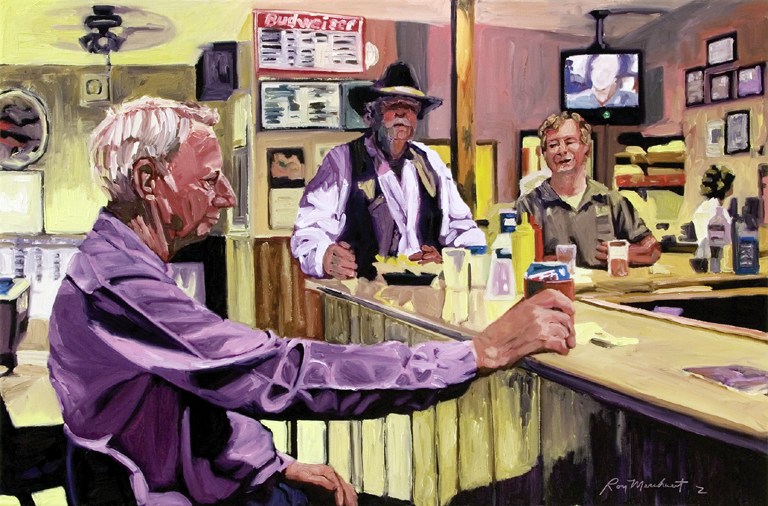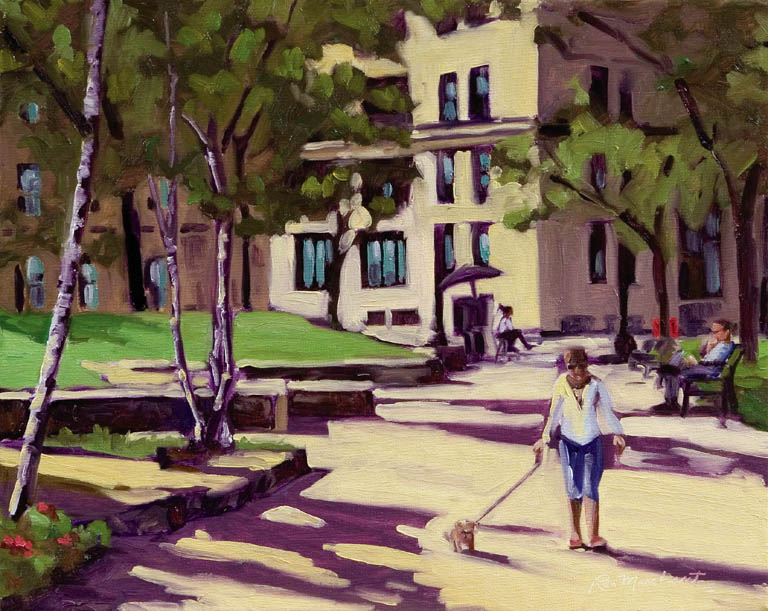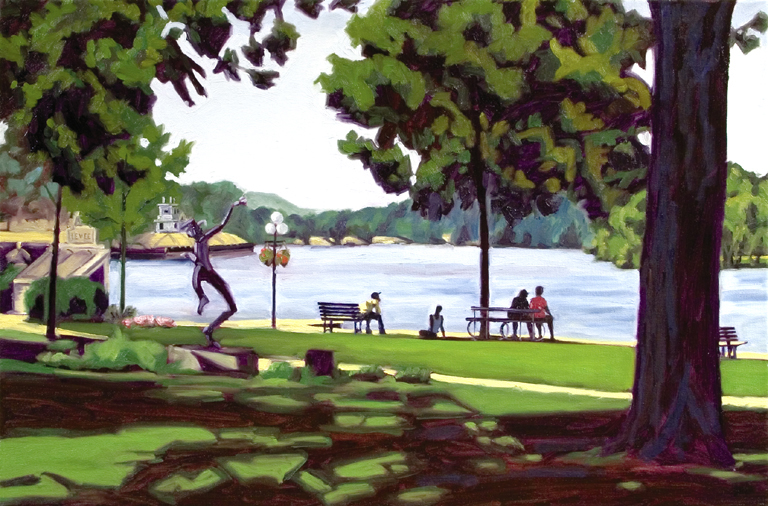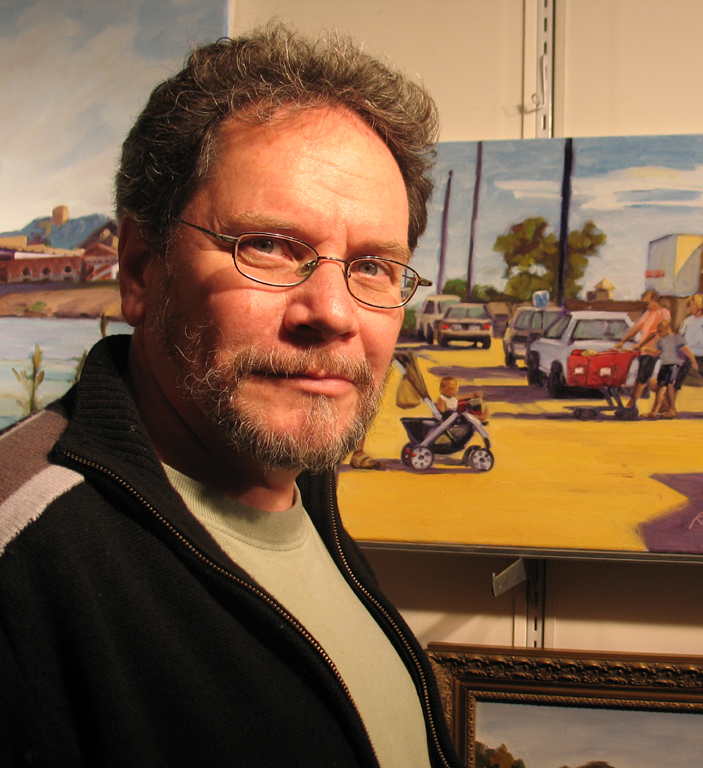A River Journey: Ron Merchant
After a career reversal, Ron Merchant packed the van and embarked on a journey that would take him down the Mississippi River, to culminate in the exhibition Born by the River: People of the Mississippi River Towns. Britt Aamodt tells the story.





In 1983, Ron Merchant, in his early thirties, sat down to reflect on life. He and wife Cherlynn took a sheet of blue-lined paper and began to write: 1969—got married; 1969—Jason is born; 1972—bought the duplex; 1973—Naz is born.
They continued to catalog milestones. For every year together, they picked events that said, This is who we are; this is how we got here. The account passed 1983 and moved optimistically ahead, to 1984…1990…2000…2005, anticipating the high school graduations and university diplomas of sons Jason, Naz, Alex, and Ben.
Yet for all their forward thinking, the couple could never have predicted the day in 2001 when Merchant, part of an elite telecommunications sales force, was told he was no longer needed; nor could they have foreseen the surfacing of artistic ambitions at an age when most people are planning retirement and buying condos in Arizona.
But it happened..
Telecommunications sales, to which Merchant had given twenty-two years, had gone belly up in the aftermath of the techcom bubble. And now his company was asking him to leave.
“The most expensive part of a company is its payroll,” explained Merchant, who’d seen the biggest sales year of his life in 1999 when industries, worried about Y2K, anxiously snatched up his custom software packages. “So after telecom crashed, my company said we’re making it really attractive for you to leave.”
Merchant and some of his colleagues were offered early retirement.
“We could take the pension and leave, or we could stay and see what happened. If I’d stayed, by now my job would have been gone.”
He took the pension. He took the 70-percent cut in pay. And though he said he felt like an 18-year-old given his first taste of freedom, there were days when he didn’t know who he was.
“It was tough. I was 50, and I’d spent 22 plus years with a business card that defined my identity,” he said. “When people first meet you, especially in the United States, they say, ‘What do you do?’ They don’t say, ‘How are you?’ They don’t ask about your family. It’s all about doing versus being.”
Merchant’s answer was to print a series of business cards, titled “Renaissance Project,” that identified him as a doer of music, art and word. He was going to do what he’d always wanted.
What he did was everything: Italian lessons, accordion practice, musical jams with men half his age, art history courses, poetry, songwriting, river walks, painting. This was his time to discover. He’d helped put his children and his wife through school, now it was his turn to finish the education he’d begun years before at the University of Minnesota but was never able to complete.
In this whirlwind of activity, Merchant began to notice a pattern. He was drawn to art. More and more, his interests gravitated to lessons in design and composition and workshops in oil painting.
Since he was a boy, he’d been interested in art. But the more he dabbled in the Renaissance Project, the more certain Merchant became that oil painting was the medium he sought to express the creativity common to all humanity that is often submerged in the chores of daily life.
Within a few years, with the focus and enthusiasm he’d once brought to telecom sales, Merchant immersed himself in the new medium. He built a studio in his South Minneapolis home. He joined artist groups. He participated in an intensive plein air workshop, and then applied the lessons on the Nicollet Mall. Every other Tuesday, 10am to 2pm, he set up his easel and painted the Mall with all its frenzied activity, its vendors, café sitters, business suits and bustle. He honed his craft.
“While all this was happening,” said Merchant, “mnartists.org was doing a kickoff for their new website called ‘5 Minutes of Fame’ and they had instructions to make a 25-piece, five-minute show of your work. So, I submitted a show and they selected it to feature on their website rollout.”
It was through mnartists.org, too, that the budding landscape painter learned of the Minnesota State Arts Board’s Artist Initiative grant. His idea was to select eight communities along the Minnesota portion of the Mississippi River and document life in those towns. The subject was close to the artist, who was born and raised in Minneapolis, a short distance from the river that had spawned his city and powered its commercial evolution from timber to flour milling to service industries and tourism.
The MSAB said yes.
May to September 2005, Merchant visited Itasca State Park, Jacobson, St. Cloud, Elk River, Minneapolis, St. Paul, Red Wing and Winona, moving from the headwaters in Lake Itasca and following the stream as it built over miles into the massive brown tide at the border of Minnesota and Wisconsin.
At each site he moved into town for three to four days of intensive painting, photographing, talking to people and recording interviews. He got his hair cut. He filled his tank. He ate at the local diner and drank at the local watering hole, trying to imbue his work with a sense of place and time.
The resulting one-man exhibition Born by the River: People of the Mississippi River Towns premiered May 6, 2006 at Robbin Gallery in Robbinsdale. The 40 canvases, 60 photographs, and 26 transcribed interviews represent, according to art historian Roslye B. Ultan, Merchant’s “lifelong affinity to the environment and his fascination with everyday happenings of ordinary middle class American citizens in their habitual landscapes.”
In her eloquent introduction to the exhibition’s 144-page companion book, also called Born by the River, Ultan describes the artist’s impressionistic loose brushwork and the “psychologically laden” light that pervades the canvases and invites the viewers “to become part of these electrified landscapes on the banks of the Mississippi River.”
Ochres and purples predominate in a visual motif that unifies the series. In “A Spot of Shade” (Red Wing), deep purples occupy the foreground and push the viewer along a jagged ice floe of purple shadow and green lawn to the luminous Mississippi, trimmed by golden paths and river bluffs. There is a sense of opening up as the heavy foliage gives way to blue sky.
“I try to keep my style loose, not so defined, so that viewers can make their own interpretations,” said Merchant, an approach clearly visible in “Dog Walking Mears Park.”
Here, a lone dog walker basks in the warmth of afternoon light. The atmosphere is dreamlike.
Of his artistic journey, Merchant said it has been everything he expected and more.
“I had high expectations for Born by the River. I thought it was going to be fun and exciting and a lot of work. And it’s been all those. But what’s surprised me most is that I haven’t run into a single negative or antagonistic person. Everyone’s been consistently supportive of the project.”
The other night, Merchant received a phone call at 10:30pm. “No one calls me at 10:30pm,” he said, but it was Al Kapala, a man he’d met in Jacobson, a town southeast of Grand Rapids with a gas station and bar (seen in the painting “Tall Tales”) and not much else. “I sent Al a copy of the book, which included a transcript of the interview I’d done with him. He wanted to tell me he’d gone through it three times already and that he thought I should write another.”
Al will have to wait. May through December 2006, Merchant is touring Born by the River: People of the Mississippi River Towns to seven Minnesota cities.
Information about the exhibit and the companion book is available online at www.mnartists.com/Ron_Merchant or www.ronmerchant.com.